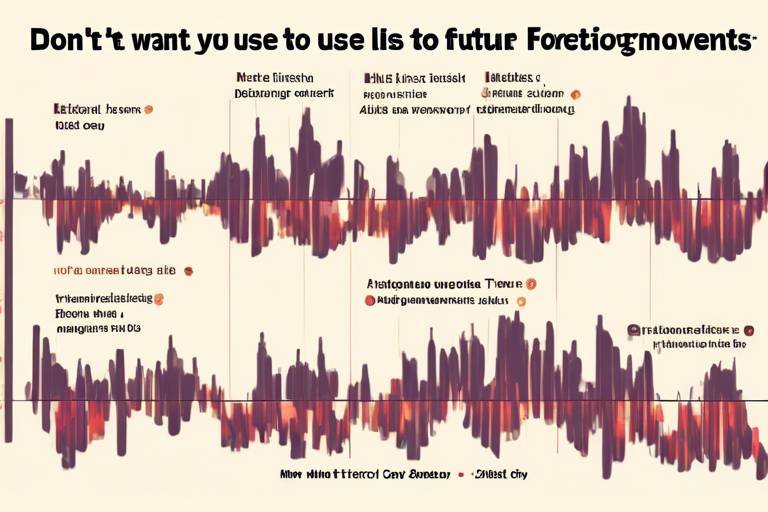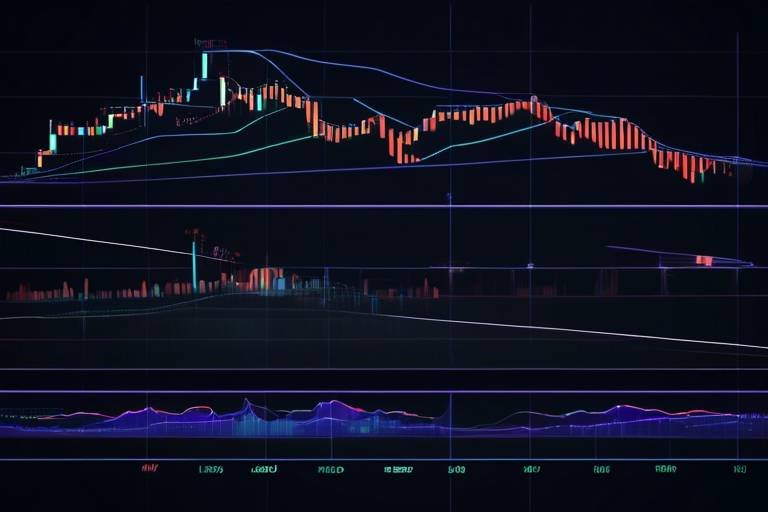The Role of Support and Resistance in Technical Trading
In the dynamic world of trading, understanding the concepts of support and resistance is akin to having a compass in the wilderness. These vital price levels can guide traders through the tumultuous waters of the financial markets, helping them make informed decisions that can lead to profitable outcomes. But what exactly are support and resistance levels? Simply put, support levels act as a safety net during price declines, while resistance levels serve as barriers during price increases. Grasping these concepts not only enhances your trading strategy but also sharpens your market predictions. Let's dive deeper into how these levels function and why they are crucial for traders.
Support levels are like a floor in a building; they prevent prices from falling further. When the price of an asset approaches a support level, buying interest tends to increase, creating a protective barrier against further declines. This phenomenon occurs because traders perceive these levels as attractive entry points, leading to increased demand. Think of it as a crowded elevator: once it hits the ground floor, people are eager to get in, preventing it from descending any further. The significance of support levels extends beyond mere price points; they can also provide insights into market sentiment and potential reversal points.
On the flip side, resistance levels are the ceilings that can halt price increases. When prices approach these levels, selling interest typically rises as traders look to lock in profits, leading to a potential price reversal. Imagine a balloon being inflated: as it gets closer to its maximum size, the pressure builds until it eventually pops. Similarly, when prices hit a resistance level, they may face significant selling pressure, making it challenging for them to rise further. Recognizing these levels is essential for traders, as they can help identify potential entry and exit points.
Traders employ various methods to identify support and resistance levels, using tools like historical price data and technical indicators. One effective technique is analyzing past price movements to pinpoint where prices have previously reversed. Additionally, traders often look at key psychological levels, such as round numbers, as they tend to attract buying or selling interest. By combining these methods, traders can create a more robust trading strategy that takes advantage of these critical price points.
Trend lines are essential tools in visualizing support and resistance. By connecting the highs or lows of price movements, traders can draw trend lines that help identify potential future price behavior. A rising trend line can serve as a support level, while a declining trend line can act as resistance. The beauty of trend lines lies in their simplicity; they provide a clear visual representation of market trends, allowing traders to make quicker decisions. However, it's crucial to remember that trend lines are not foolproof and should be used in conjunction with other indicators.
Another powerful tool in identifying support and resistance is the use of moving averages. These averages smooth out price data over a specified period, helping traders identify potential support and resistance zones. For instance, the 50-day and 200-day moving averages are commonly used to gauge long-term trends. When prices approach these moving averages, they often act as significant support or resistance levels. Understanding how to interpret moving averages can greatly enhance your technical analysis skills and trading strategies.
Support and resistance levels are integral to various trading strategies. Traders often use these levels to establish entry and exit points, set stop-loss orders, and manage risk. For example, a trader may decide to enter a long position when the price bounces off a support level, believing that the price will rise. Conversely, they might choose to exit a trade or set a stop-loss order when the price approaches a resistance level. By incorporating support and resistance into their trading strategies, traders can make more informed decisions that align with market movements.
Market psychology plays a significant role in the effectiveness of support and resistance levels. Understanding trader sentiment can provide valuable insights into potential price movements. For instance, if a large number of traders believe that a certain support level will hold, their collective buying interest can reinforce that level. On the other hand, if sentiment shifts and traders start to doubt the strength of a support level, it may lead to a breakout. Recognizing these psychological factors can help traders anticipate potential market behavior and adjust their strategies accordingly.
To gauge market sentiment effectively, traders can utilize various methods, such as sentiment indicators and news analysis. For instance, a high level of bullish sentiment may indicate that a resistance level is likely to hold, while bearish sentiment could suggest a potential breakout below a support level. Monitoring social media, news headlines, and economic reports can also provide insights into market sentiment. By staying informed, traders can better anticipate potential breakouts or reversals at support and resistance levels.
Despite the importance of support and resistance levels, traders often make common mistakes when interpreting them. One frequent pitfall is relying solely on historical levels without considering the current market context. Additionally, traders may misinterpret price action around these levels, leading to premature entry or exit decisions. To avoid these mistakes, it's crucial to combine support and resistance analysis with other technical indicators and market analysis. This holistic approach can significantly improve trading outcomes and increase the likelihood of success.
- What are support and resistance levels?
Support levels prevent price declines, while resistance levels halt price increases. - How can I identify support and resistance?
You can identify these levels using historical price data, trend lines, and moving averages. - Why are support and resistance important?
They help traders make informed decisions regarding entry and exit points in their trading strategies. - How does market psychology affect support and resistance?
Trader sentiment can reinforce or weaken these levels, influencing potential price movements.

Understanding Support Levels
Support levels are like the safety nets of the trading world. Imagine you're at a carnival, and there’s a bungee jump. The moment you leap off, you’re met with a sturdy harness that catches you before you hit the ground. In trading, support levels serve a similar purpose; they act as price floors where buying interest emerges, preventing prices from declining further. When traders notice that an asset is consistently bouncing off a certain price point, they begin to see this level as a place where the demand is strong enough to overcome selling pressure.
But what makes support levels so significant in trading strategies? First off, they provide a clear indication of where buyers are stepping in. When the price approaches a support level, it’s almost like a magnet pulling traders in, as they anticipate a potential reversal. This anticipation creates a self-fulfilling prophecy; as more traders buy at or near the support level, the price tends to stabilize or even bounce back up, reinforcing the validity of that support level.
Support levels are not just random numbers; they are derived from various factors, including historical price data and market psychology. For example, if a stock has repeatedly bounced back from $50, that level becomes a psychological barrier for traders. They start to think, “Hey, this stock seems to like $50. Maybe I should buy when it gets close to that!” This collective mindset can create a strong buying force at that price point.
Moreover, support levels can be dynamic. They can change based on market conditions, news events, or even shifts in trader sentiment. For instance, if a company releases a disappointing earnings report, the previous support level might no longer hold, and traders will need to reassess where the new support lies. Thus, it's essential for traders to stay vigilant and continuously analyze price movements to identify these critical levels.
In summary, understanding support levels is crucial for traders looking to enhance their decision-making processes. By recognizing where these levels lie, traders can better position themselves to capitalize on potential reversals and mitigate risks. The next time you look at a price chart, keep an eye out for those support levels—they could very well be the key to your trading success!

Understanding Resistance Levels
Resistance levels are critical concepts in technical trading, acting as the price ceilings where selling interest tends to emerge. Imagine you're at a concert, and the energy in the crowd is building up as the band prepares to play their biggest hit. Just when you think the excitement will peak, the band holds back, creating a moment of suspense. This is similar to what happens at resistance levels in the market; traders anticipate a price surge but are met with selling pressure that halts the upward movement. Understanding these levels can significantly enhance your trading strategy and decision-making process.
Resistance levels are not just arbitrary points on a chart; they are psychological barriers formed by the collective behavior of traders. When a security approaches a resistance level, sellers often step in, believing that the price will not go higher. This belief can create a self-fulfilling prophecy, where the more traders sell at this level, the more it reinforces the resistance. In essence, resistance levels reflect the market's sentiment and the balance between supply and demand.
To better grasp the significance of resistance levels, let's explore a few key characteristics:
- Historical Significance: Resistance levels often align with previous highs, where the price struggled to break through in the past. Traders look at these historical points to anticipate future behavior.
- Volume Considerations: A resistance level with high trading volume is typically more robust. If many traders are selling at that price, it indicates strong conviction.
- Multiple Touches: The more times a price level is tested as resistance without being breached, the stronger that resistance is considered. This is akin to a sturdy wall that has withstood several attempts to break through.
Recognizing these characteristics can help traders make informed decisions. For instance, if a stock consistently bounces back from a particular price point, it may be wise to set sell orders just below that level. On the flip side, if the price does break through a resistance level, it could signal a potential bullish trend, prompting traders to adjust their strategies accordingly.
Furthermore, resistance levels can also be dynamic. They can change as market conditions evolve, influenced by news events, economic data, and trader sentiment. This fluidity means that traders must remain vigilant and adaptable, continuously reassessing their charts and strategies. For example, if a company releases a groundbreaking product, the previously established resistance levels may no longer hold, and traders must be prepared for rapid price changes.
In summary, understanding resistance levels is crucial for traders aiming to navigate the complexities of the market. By recognizing these price ceilings and the psychological factors at play, traders can make more informed decisions and enhance their overall trading strategies. As we delve deeper into this topic, we will explore how to identify these levels effectively and incorporate them into your trading plan.

Identifying Support and Resistance
Identifying support and resistance levels is like being a detective in the world of trading. You need to sift through the clues left by price movements to uncover where the market might turn. These levels are not just random numbers; they represent the collective psychology of traders. When prices approach these levels, they often react based on historical behavior. So, how do traders effectively pinpoint these critical junctures? Let’s dive into some effective techniques!
One of the most common methods is analyzing historical price data. By looking at past price movements, traders can identify where prices have previously bounced back (support) or where they have struggled to rise above (resistance). For instance, if a stock has consistently bounced off $50, this price point becomes a significant support level. Conversely, if it has repeatedly failed to break through $100, that’s a resistance level. The more times a price has tested these levels, the more significant they become.
Another effective technique involves using technical indicators. Some traders rely on tools like Fibonacci retracement levels, which can help identify potential support and resistance zones based on the mathematical relationships between numbers. Additionally, indicators such as the Relative Strength Index (RSI) or the Moving Average Convergence Divergence (MACD) can provide insights into market momentum, which can help confirm whether a support or resistance level is likely to hold.
Moreover, volume analysis is crucial in identifying these levels. High trading volume at a particular price level often indicates strong interest from buyers or sellers, making it more likely that the price will react at that level. For example, if a stock experiences a surge in volume as it approaches a support level, this could suggest that buyers are stepping in, reinforcing the support. Conversely, if volume spikes at a resistance level, it may indicate that sellers are becoming active, making it harder for prices to break through.
Lastly, traders often use trend lines to visualize support and resistance. By connecting the lows in an uptrend or the highs in a downtrend, traders can create lines that act as dynamic support or resistance levels. These trend lines can be drawn at various angles, providing valuable insights into potential future price movements. A break of a trend line, especially with significant volume, can signal a change in the market direction, making it a critical area to watch.
In summary, identifying support and resistance is a multifaceted process that combines historical analysis, technical indicators, volume analysis, and trend lines. By mastering these techniques, traders can enhance their decision-making skills and potentially improve their trading outcomes. Remember, the market is a living entity, and understanding its behavior at these critical levels can give you the edge you need to succeed.

Trend Lines
Trend lines are more than just straight lines on a chart; they are powerful tools that help traders visualize the market's direction and identify potential support and resistance levels. By connecting a series of price points, these lines provide a clear indication of the prevailing trend, whether it’s upward, downward, or sideways. Imagine trend lines as the guiding rails on a train track, steering your trading decisions in the right direction. But how exactly do you draw and interpret these lines effectively?
To draw a trend line, start by identifying at least two significant price points on your chart. For an upward trend, connect the lows, and for a downward trend, connect the highs. The more points you can connect, the stronger your trend line will be. Just like a well-constructed bridge, a strong trend line can withstand the market's fluctuations and provide a reliable reference point for traders.
Once you’ve established your trend lines, it's essential to watch how the price interacts with them. If the price approaches a trend line and bounces off, it reinforces the idea that the line is acting as a support or resistance level. However, if the price breaks through a trend line, it could signal a change in trend, much like a sudden detour on your journey. This is where traders need to be alert and ready to adjust their strategies.
Moreover, trend lines can also be used in conjunction with other technical indicators to enhance trading decisions. For instance, when a price tests a trend line while also aligning with a moving average, the confluence of these indicators can provide a stronger signal for entry or exit points. Think of it as having multiple GPS systems guiding you to your destination; the more confirmations you have, the more confident you can be in your decision.
In conclusion, mastering the art of drawing and interpreting trend lines can significantly enhance your trading strategy. They offer clarity in a chaotic market and help traders make informed decisions. Just remember, while trend lines are valuable tools, they should not be used in isolation. Always consider the broader market context and combine them with other analytical methods for the best results.

Moving Averages
Moving averages are among the most popular tools in a trader's arsenal, serving as a vital indicator of potential support and resistance levels. Essentially, a moving average smooths out price data by creating a constantly updated average price. This helps traders to filter out the "noise" from random price fluctuations and focus on the underlying trend. There are various types of moving averages, including the Simple Moving Average (SMA) and the Exponential Moving Average (EMA), each offering unique insights into market behavior.
The Simple Moving Average (SMA) is calculated by taking the average of a set number of closing prices over a specific period. For instance, a 50-day SMA adds up the closing prices of the last 50 days and divides it by 50. This average changes as new data comes in, which means that it can serve as a dynamic support or resistance level. Traders often look for price interactions with the SMA, as these can indicate potential reversals or continuations in the trend.
On the other hand, the Exponential Moving Average (EMA) gives more weight to recent prices, making it more responsive to new information. This characteristic can be particularly useful in fast-moving markets, where timely decisions are crucial. The EMA can act as a support level during upward trends and a resistance level during downward trends. By observing how the price interacts with the EMA, traders can gain insights into potential market reversals or continuations.
To visualize the significance of moving averages, consider the following table that compares the SMA and EMA:
| Feature | Simple Moving Average (SMA) | Exponential Moving Average (EMA) |
|---|---|---|
| Calculation Method | Average of closing prices over a specific period | Weighted average that gives more importance to recent prices |
| Responsiveness | Less responsive to recent price changes | More responsive to recent price changes |
| Best Used For | Identifying longer-term trends | Spotting short-term price movements |
Incorporating moving averages into your trading strategy can enhance your ability to identify potential support and resistance levels. For instance, many traders use a combination of the 50-day and 200-day moving averages to identify bullish or bearish trends. When the 50-day EMA crosses above the 200-day EMA, it signals a potential bullish trend, often referred to as a "golden cross." Conversely, when the 50-day EMA crosses below the 200-day EMA, it indicates a bearish trend, known as a "death cross."
However, it's essential to remember that while moving averages can provide valuable insights, they are not foolproof indicators. Market conditions can change rapidly, and relying solely on moving averages without considering other factors can lead to poor trading decisions. Therefore, it's crucial to combine moving averages with other technical indicators and analysis methods to create a well-rounded trading strategy.
- What is the best moving average for trading? The best moving average often depends on your trading style. Short-term traders may prefer shorter moving averages like the 10 or 20-day, while long-term traders might look at the 50 or 200-day moving averages.
- How can I use moving averages to identify trends? Moving averages can help identify trends by showing the direction of price movement. If the price is consistently above a moving average, it indicates an uptrend, while prices below suggest a downtrend.
- Can moving averages predict future prices? While moving averages can indicate potential support and resistance levels, they do not predict future prices. They are best used in conjunction with other indicators and market analysis.

Role in Trading Strategies
In the world of technical trading, understanding support and resistance levels is not just an academic exercise; it's a crucial part of a trader's toolkit. These levels serve as the backbone of many trading strategies, helping traders make informed decisions. Imagine you're navigating through a dense forest; support and resistance levels act like signposts, guiding you toward potential opportunities and away from pitfalls. By incorporating these levels into their strategies, traders can enhance their chances of success and minimize risks.
One of the primary ways traders utilize support and resistance is through the concept of entry and exit points. When a price approaches a support level, many traders view this as a potential buying opportunity, anticipating that the price will bounce back up. Conversely, when prices near a resistance level, traders often see this as a signal to sell, expecting a reversal. This dynamic creates a self-fulfilling prophecy, as many traders act on these levels, further solidifying their importance in the market.
Moreover, support and resistance can also be used to set stop-loss and take-profit orders. For instance, a trader might place a stop-loss order just below a support level, as breaking this level could indicate a stronger downward trend. Similarly, take-profit orders can be set near resistance levels to capitalize on expected price reversals. This strategic use of support and resistance not only helps in managing risk but also in maximizing profits.
Another fascinating aspect of support and resistance is their role in identifying trending markets. In a strong uptrend, the previous resistance levels often become new support levels as the price continues to rise. This phenomenon is sometimes referred to as "support becoming resistance" and vice versa. Understanding this concept can help traders adjust their strategies in real-time, allowing them to ride the trends more effectively.
To illustrate the significance of support and resistance in trading strategies, consider the following table that summarizes key roles they play:
| Role | Description |
|---|---|
| Entry Points | Identifying potential buying opportunities at support levels. |
| Exit Points | Recognizing selling opportunities at resistance levels. |
| Risk Management | Setting stop-loss orders just below support or above resistance. |
| Trend Identification | Using previous resistance as new support in an uptrend. |
In conclusion, support and resistance levels are not merely lines on a chart; they are vital components of effective trading strategies. By understanding how to leverage these levels, traders can make more informed decisions, anticipate market movements, and ultimately improve their trading performance. So, the next time you're analyzing a chart, remember the power of these levels; they could be the key to unlocking your trading potential.
- What are support and resistance levels?
Support levels are price points where buying interest emerges, preventing further declines, while resistance levels are where selling interest arises, halting upward movements.
- How can I identify support and resistance levels?
Traders can identify these levels using historical price data, trend lines, and various technical indicators.
- Why are support and resistance important?
They help traders make informed decisions about entry and exit points, manage risk, and identify potential market trends.
- Can support and resistance levels change over time?
Yes, they can evolve as market conditions change, and previous support levels can become resistance levels and vice versa.

Psychological Factors
When it comes to trading, the mindset of the trader can be just as important as the technical indicators on the charts. The influencing support and resistance levels are often underestimated, yet they play a critical role in market dynamics. Traders are not just numbers and charts; they are human beings driven by emotions such as fear, greed, and hope. These emotions can lead to irrational decisions that affect market movements, often causing price action to react at these critical levels.
Consider this: when a stock approaches a support level, many traders feel a sense of optimism, believing it signifies a good buying opportunity. Conversely, as the price nears a resistance level, a wave of anxiety may wash over them, prompting thoughts of selling to lock in profits. This emotional rollercoaster can create a self-fulfilling prophecy where traders collectively push prices up or down, reinforcing these levels. The psychological aspects of trading can often lead to market sentiment that either supports or challenges the established support and resistance.
Moreover, the concept of market sentiment can be broken down into two primary components: bullish sentiment and bears sentiment. Bullish traders believe that prices will rise, often leading to stronger buying pressure at support levels. On the other hand, bearish traders expect prices to fall, contributing to selling pressure at resistance levels. Understanding these sentiments can help traders anticipate potential breakouts or reversals. To better grasp how these sentiments can shift, let’s take a look at the following table:
| Market Sentiment | Impact on Support | Impact on Resistance |
|---|---|---|
| Bullish | Increased buying interest, potential bounce | Less selling pressure, potential breakout |
| Bearish | Increased selling pressure, potential breakdown | Increased selling interest, potential reversal |
Understanding these psychological factors can equip traders with the tools needed to navigate the market effectively. However, it’s essential to remain aware of common pitfalls. For instance, many traders fall into the trap of confirmation bias, where they only seek information that supports their existing beliefs about market direction. This can lead to poor decision-making, especially when approaching support and resistance levels. To avoid this, it's crucial to maintain a balanced perspective and consider all available data.
In conclusion, psychological factors are an integral part of trading that cannot be ignored. Recognizing the emotions at play and understanding market sentiment can significantly enhance a trader's ability to make informed decisions. By combining technical analysis with a keen awareness of psychological influences, traders can develop a more robust approach to navigating the complexities of the market.
- What are support and resistance levels?
Support levels are price points where buying interest is strong enough to prevent prices from falling further, while resistance levels are where selling interest is strong enough to stop prices from rising. - How do psychological factors influence trading?
Emotions such as fear and greed can lead traders to make irrational decisions, impacting the effectiveness of support and resistance levels. - What is market sentiment?
Market sentiment refers to the overall attitude of traders towards a particular security or financial market, which can affect the behavior of support and resistance levels. - How can I improve my trading psychology?
Developing a trading plan, practicing mindfulness, and maintaining a balanced perspective on market data can help improve trading psychology.

Market Sentiment Analysis
Understanding market sentiment is like trying to read the mood of a crowd at a concert—sometimes it’s electric, and other times, it feels like a lull. In trading, market sentiment refers to the overall attitude of investors toward a particular security or the market as a whole. It plays a crucial role in determining how support and resistance levels behave. When traders are optimistic, they are more likely to buy, pushing prices up and creating resistance. Conversely, when fear sets in, selling pressure increases, leading to support levels being tested.
One effective way to gauge market sentiment is through sentiment indicators. These tools can provide insights into whether the market is leaning bullish or bearish. Some popular sentiment indicators include:
- Put/Call Ratio: This ratio compares the number of put options (bearish bets) to call options (bullish bets). A high ratio indicates bearish sentiment, while a low ratio suggests bullish sentiment.
- Market Volatility Index (VIX): Often referred to as the "fear gauge," the VIX measures market expectations of near-term volatility. A rising VIX typically signals increased fear, while a declining VIX indicates a sense of calm.
- Surveys and Polls: Many organizations conduct surveys to assess investor sentiment. These can provide qualitative insights into how traders feel about market conditions.
Moreover, social media platforms and financial news outlets have become invaluable resources for gauging sentiment. The Twitter sentiment analysis has gained traction, where traders analyze tweets to understand the prevailing mood of the market. For instance, a surge in negative tweets about a stock might indicate a potential downturn, while a flurry of positive tweets could suggest a bullish trend.
It's essential to remember that market sentiment can create self-fulfilling prophecies. For example, if a significant number of traders believe a stock is going to rise, their collective buying can push the price up, reinforcing their original belief. This phenomenon can cause prices to bounce off support levels or fail to break through resistance levels, which is critical for traders to recognize.
In summary, market sentiment analysis is a powerful tool that can enhance your trading strategy. By keeping an eye on various sentiment indicators and understanding the psychological factors at play, you can make more informed decisions about when to enter or exit trades. Just like a skilled conductor leading an orchestra, being attuned to market sentiment can help you harmonize your trading actions with the rhythm of the market.

Common Mistakes
When it comes to trading, understanding support and resistance levels is crucial, but many traders often stumble into common pitfalls that can derail their strategies. One major mistake is over-relying on these levels without considering the broader market context. Support and resistance are not foolproof; they can be broken, and a trader who places too much faith in them may find themselves on the wrong side of a trade. Think of support as a trampoline; while it might bounce you back up, if you jump too hard, you could end up hitting the ground instead!
Another frequent error is the misinterpretation of breakouts. Just because a price breaks through a support or resistance level does not guarantee that it will continue in that direction. Traders often get excited and jump into trades, believing a new trend has begun, only to see the price reverse shortly after. It’s essential to confirm breakouts with additional indicators or volume analysis. A breakout without volume is like a party without guests—there’s just no energy to sustain it!
Additionally, many traders fail to account for psychological factors that can impact these levels. Market sentiment can shift rapidly, causing levels that once held firm to crumble. For instance, if a significant news event occurs, it might cause traders to panic and sell, breaking through what was once a strong support level. Ignoring the emotional landscape of the market can lead to costly mistakes.
One way to avoid these pitfalls is to develop a comprehensive trading plan that incorporates support and resistance levels as part of a broader strategy. This plan should include risk management techniques, such as setting stop-loss orders, to protect against unexpected market movements. Remember, trading without a plan is like sailing without a map; you might end up lost at sea!
To summarize, here are some common mistakes to watch out for:
- Over-reliance on support and resistance levels without considering market context.
- Misinterpreting breakouts without confirming with volume or other indicators.
- Ignoring psychological factors that can affect market behavior.
Avoiding these mistakes requires discipline and a willingness to adapt your strategies based on market conditions. By being aware of these common traps, traders can significantly improve their chances of success in the ever-evolving world of technical trading.
Q1: What are support and resistance levels?
A1: Support levels are price points where buying interest is strong enough to prevent the price from falling further, while resistance levels are where selling interest is strong enough to prevent the price from rising further.
Q2: How can I identify these levels?
A2: Traders often use historical price data, trend lines, and technical indicators to identify support and resistance levels.
Q3: Can support and resistance levels change?
A3: Yes, support and resistance levels can change based on market conditions, trader sentiment, and significant news events that impact price movements.
Q4: What should I do if a support or resistance level is broken?
A4: It's essential to confirm the breakout with volume and other indicators before making trading decisions. A broken level may indicate a new trend, but it can also lead to a false breakout.
Frequently Asked Questions
- What are support and resistance levels in trading?
Support and resistance levels are critical price points on a chart that indicate where the price of an asset tends to stop and reverse. Support levels act as a floor, preventing the price from falling further, while resistance levels act as a ceiling, stopping the price from rising above a certain point.
- How can I identify support and resistance levels?
Traders identify support and resistance levels through various methods, including analyzing historical price data, using trend lines, and applying technical indicators such as moving averages. These techniques help traders pinpoint where buying or selling pressure is likely to emerge.
- Why are support and resistance important in trading strategies?
Support and resistance levels are vital for making informed trading decisions. They provide insights into potential entry and exit points, helping traders to manage risk and maximize profits. By understanding these levels, traders can better anticipate market movements.
- What role does market psychology play in support and resistance?
Market psychology significantly influences support and resistance levels. Trader sentiment can lead to increased buying or selling pressure at these levels, resulting in potential breakouts or reversals. Understanding market sentiment helps traders make more accurate predictions about price movements.
- What are common mistakes traders make with support and resistance?
Some common mistakes include misinterpreting the strength of support and resistance levels, failing to account for market news or events, and not adjusting their strategies based on evolving market conditions. Avoiding these pitfalls can lead to better trading outcomes.



















